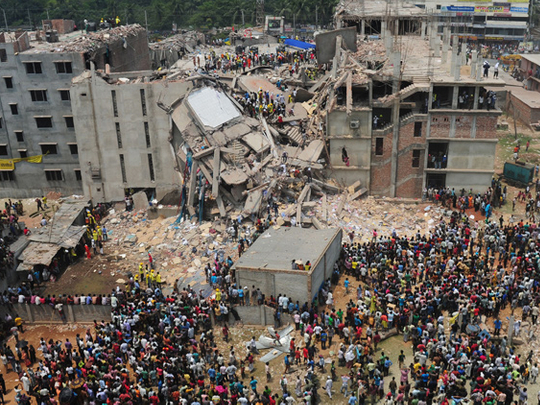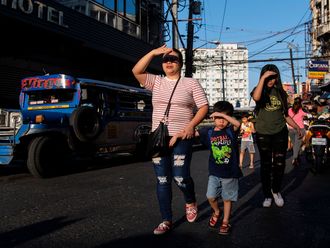
Savar, Bangladesh: The death toll in Bangladesh's worst factory disaster climbed past 300 on Friday, as thousands of people still surrounded the site outside the capital in search of missing relatives.
"The death toll is now 304," army spokesman Shahinul Islam said, adding that more than 3,000 people have been rescued alive since the building collapsed on April 24, including 72 on Friday.
Dozens of workers were found alive on Thursday as they huddled in the wreckage of a collapsed garment factory bloc in Bangladesh, a rare success for rescuers.
In an announcement greeted by wild applause from thousands of relatives at the scene, an army spokesman initially announced that 40 survivors had been discovered together in a room, but the figure was later revised to 24.
Screams filtering through the cracks in the concrete suggested more survivors were awaiting help, but a steady stream of bodies saw the recorded death toll almost double on Thursday and hundreds remain unaccounted for.
The collapse of the building on Wednesday on the outskirts of the capital is the worst industrial accident in the country's history and is the latest in a spate of tragedies in the "Made in Bangladesh" clothing sector.
It prompted new criticism of Western brands who were accused by activists of placing profit before safety by sourcing their products from the country despite its shocking track record of deadly disasters.
Hundreds of thousands of workers walked out of their factories in solidarity with their dead colleagues on Thursday as flags flew at half mast and a national day of mourning was held.
Safety problems and poor working conditions plague the textile industry in Bangladesh, the world's second-biggest clothing exporter after China. Last November a blaze at a factory making products for Walmart and other Western labels left 111 people dead, with survivors describing how fire exits were kept locked by site managers.
Only British low-cost fashion line Primark and Spanish giant Mango have acknowledged having their products made in the collapsed factory bloc, while a host of brands including Wal-Mart and France's Carrefour are investigating.
Italian fashion line Benetton denied having a supplier in the building but a local workers' group provided documents showing apparent orders from the company in August and September last year.
The company did not reply to repeated requests from AFP for comment.
Survivors said the building developed visible cracks on Tuesday evening, but factory bosses had demanded staff return to the production lines despite a police evacuation order. One manager for the New Wave Styles company, one of the five manufacturers in the building, told how the owner had consulted an engineer but then ignored his warnings. "Those who're involved, especially the owner who forced the workers to work there, will be punished," Prime Minister Sheikh Hasina told lawmakers. "Wherever he is, he will be found and brought to justice."
At the scene of the disaster, relatives desperate for news descended in their thousands, clutching photographs and hoping to see their missing loved ones pulled out by firemen and soldiers.
"I became so thirsty that at one stage I drank my urine," said an ecstatic Abul Hossain, 23, as he was dragged from the ruins more than 25 hours after the disaster struck at around 09:00 am (0300 GMT) on Wednesday.
'Blind eye to the manufacturers' shoddy practices'
But others were less lucky, with body after body laid out on the grounds of a nearby school for identification.
"I've seen all the bodies. My sister was not among them. She is also not in any of the hospitals," said Mukta Begum, holding the photo of her younger sibling Suryaban, a garment worker.
Babul Akhter, head of the Bangladesh Garments and Industrial Workers Federation, told AFP that the factory owners - who have gone into hiding - would likely escape justice despite the outcry.
"Garment entrepreneurs are above the law here. There is hardly any example of an owner being prosecuted for this kind of outright murder," he said. "The Western retailers are also complicit because they give a blind eye to the manufacturers' shoddy practices."
Before the 24 were found, Ahmed Ali, the national fire service chief, told AFP that 20 people had been rescued.
"We could still hear desperate cries for help from several places underneath the concrete heaps. Volunteers sent food and water to them through holes," he said, adding that rescuers would work through the night under floodlights.
"We're confident we can find more people alive even on Friday."
Bangladesh mourns victims
Earlier report from Anisur Rahman, Correspondent, Dhaka: The national flag fluttered at halfmast across Bangladesh as the death toll from the collapse of an eight-storey commercial building in suburban Savar on Wednesday night passed 200 and rescuers expressed fears that more than 1,500 people were still trapped under the debris.
Television footage showed relatives wailing in shock as bodies were taken to a local high school before being handed over to family members. Officials said more than 100 bodies had already been handed over to the families.
Bangladesh was on Thursday observing a one-day official mourning period following the tragedy while army and paramilitary troops joined firefighters, police and elite anti-crime Rapid Action Battalion (RAB) personnel in the salvage operations, which officials expected would take at least two days.
The building that housed three garment manufacturing units, a branch of a private bank, and some 300 shops developed cracks two days ago. Regulatory authorities said it was built in violation of safety norms, leading to the tragedy.
“The fact is we don’t know yet how many people were killed actually... but I can tell you the building was not built in compliance with the [safety] rules and regulations,” home minister Mahiuddin Khan Alamgir said.
But public anger mounted as reports said hundreds of mostly women workers of the three garments factories were virtually forced to join the work despite the precarious state of the building.
In hiding
The owners of the building and the garment factories have gone into hiding since the building collapsed while the regulatory authorities for building, Rajuk, and police filed separate cases accusing them of building an illegal structure that endangered the lives of workers.
Industrial police said two of their detectives remained untraced and were feared dead as they had ventured inside the building to investigate its condition at the time it collapsed.
The commander of the army’s Savar-based ninth division, Major General Abul Hassan Sarwardy, earlier said army engineers and rescuers were forced to proceed slowly with the salvage operations for fear that the rest of the structure could collapse, further endangering people trapped inside.
Earlier, reports said over 600 people were being treated at various city hospitals.












